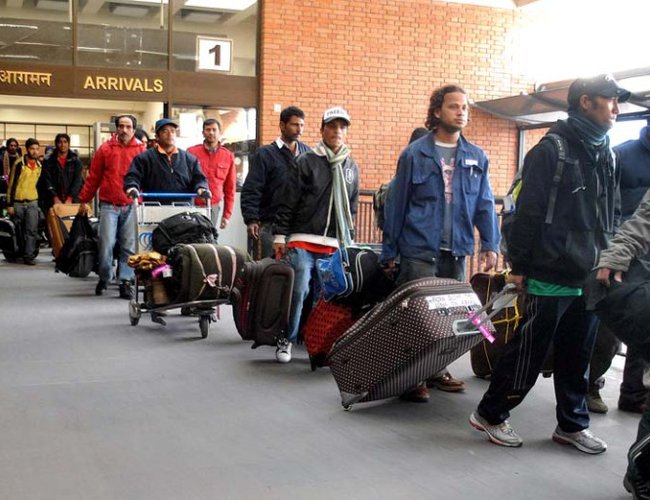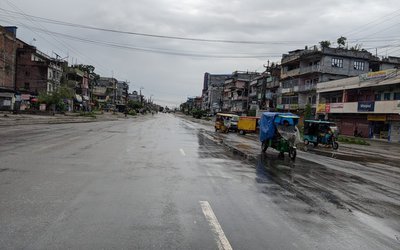
Although ambassadors of Gulf region, including Qatar, have issued assurances to Nepal government that it should not worry about the future of almost half a million migrant workers, working in Qatar, the threat to their jobs remains.
The growing tension in the region will have a major setback to Nepal’s migrant workers. According to Ministry of Labor and Employment, almost over 1.5 million Nepalese are in the Gulf region.
Following the cutting of oil prices, the demand of Nepali migrant workers has already declined in the Gulf. Department of Foreign Employment is receiving few work permit applications in the recent months, particularly from Saudi Arabia and Qatar, two largest destinations for Nepali migrants.
Ambassador of Qatar to Nepal Yousuf Bin Mohammed Al-Hail, in his recent meetings with Deputy Prime Minister and Foreign Minister Krishna Bahadur Mahara and Minister of Labor and Employment Farmulla Mansoor, assured that there is no threat to Nepali migrant workers.
As diplomatic rift between Qatar and the Saudi Arabia-led alliance has hit the psychology of workers and many are in a wait and see mode at the moment, there is drastic drops of number of workers leaving TIA.
Although ambassadors from Gulf countries including Qatar continue to say that the present dispute will not make any problems to Nepali workers, the results has shown otherwise.
There were fears in Nepal that the economic blockade put in place by the Saudi Arabia-led alliance against Qatar would hurt Nepali labourers working in the construction sector as Qatar gets ready to host the FIFA Football World Cup in 2022. However, the study team formed by the government has already said that Nepali migrant workers are safe in Qatar.
According to a Department of Foreign Employment (DoFE), the number of Nepali workers seeking jobs in the foreign labor market has decreased for the third consecutive year. It dropped by 9.61 per cent to 378,462 in the last fiscal year 2016-17.
The domestic labor market has not been able to create enough jobs for the unemployed youths and at the same time the number of migrant workers seeking foreign jobs has also declined in the last fiscal year.
In the fiscal year 2015-16, a total of 418,713 Nepalis left the country in search of jobs. The number of migrant workers who went abroad was 512,887 in the fiscal year 2014-15.
Despite the dropping the number, the January-February period witnessed the highest number of migrant workers going abroad for jobs with 37,014 migrant workers taking the final approval from DoFE while in September-October the number of migrants obtaining the final approval stood at 23,694, which was the lowest for fiscal 2016-17.
Labour market expert Ganesh Gurung said that due to political turmoil in some of the major destinations of Nepali migrant workers demand had slowed down. “We can seen that certain labour destinations are facing some political problems which has led to this slowdown,” he added.
According to Gurung, the continuous fall in oil price has created economic problems in the Gulf countries and they have not hired workers like in the previous years. “The oil price has been on a continuous decline due to which the number of workers that companies are seeking has subsequently gone down and this has affected Nepal too,” he stated.
According to DoFE, the number of Nepali migrant workers willing to go to Qatar is also slightly falling down. In April-May, 9,535 migrant workers had taken the final approval from DoFE, whereas in May-June it was 8,864 and in June-July the figure had further dropped to 5,515.
“Governments of Gulf countries have assured us that Nepali migrant workers are safe in their countries and current disputes will not bring any trouble to them,” Minister of Labor and Employment Mansoor told the New Spotlight. “We are monitoring the situation carefully. If there is any crisis, we will evacuate Nepali migrant workers safely.”
As the flow of remittances continues to decline, Nepal's banking sector, which has been relying on remittances, is facing a severe cash crunch. As there is a shortage of cash, banks are borrowing money with high interest rates.
The recent crackdown on illegal migrants in Malaysia is likely to have impacts on remittances with the future of 40,000 Nepali people there at stake.
The Malaysian government’s recent move against illegal migrant workers may hit Nepali laborers in the Southeast Asian nation, which is among the most preferred labor destinations for Nepali outbound workers. Currently, around 500,000 Nepali people are working in the region.
With the growing problems in different parts of the region, the World Bank says comprehensive reforms must be made to become lower-middle-income country by 2030.
The World Bank has said that the remittances and outmigration at a large-scale is accentuating existing challenges of the country, which is in 'a low growth, high migration trap'.
Releasing Nepal Country Economic Memorandum, the World Bank said that large-scale outbound migration and remittances inflow contribute in the erosion of competitiveness, fuelling consumption, sustaining low-productivity agricultural activity and reducing pressure to generate more productive employment at home.
"Though migration and remittances have delivered gains for Nepal, it has also compounded the long term-problem of the country," said Damir Cosic, a senior economist with the World Bank.
"Remittances are providing safety net so people do not fall into poverty, but are not being used to leverage rapid growth and greater opportunity," read the report. "Large-scale migration is rapidly, and in many cases, permanently, depleting the country's stock of human capital," it added.
"And, while remittances are helping boost household expenditure. They are doing little directly to improve public service delivery. Consequently, the quality of education, health care, and infrastructure remains abysmal," stated the report.
According to the report, large-scale migration and the ensuing remittances have also contributed to the steady loss of competitiveness (through appreciation of real exchange rate) and have enabled the growth of the low-productivity services.
Out of the total workforce of 14 million, some 4 million (28 percent) are working abroad, an estimate shows.
- MELAMCHI WATER SUPPLY: No Interruption During Monsoon
- Jun 25, 2025
- KOREAN RETURNEES: Successful Integration
- Jun 25, 2025
- UPPER TRISHULI-1: Engaging With Local
- Jun 25, 2025
- IME GROUP: Twenty Five Years Of Journey
- Jun 24, 2025
- NEPAL’S AIR POLLUTION: A Growing Health Concern
- Jun 24, 2025















